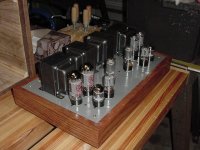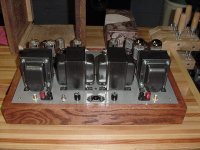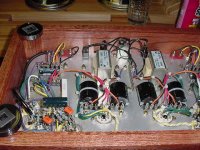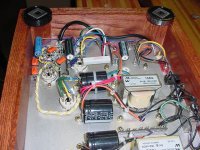Pass DIY Addict
Joined 2000
Paid Member
Hi Gabe, long time, never seen, this is the 6L6 p-p ultralinear at the tubecad site. I've been fiddling around with some other stuff and finally finished it. Here is the link to the scam http://www.tubecad.com/Classic_Articles/page5.html
Raja, here is a peek under the hood.
Raja, here is a peek under the hood.
Attachments
Ah! Fullly differential circuit! Let us know how it sounds. Been wanting to play with this circuit for a long time, to see how it compares to my MAG.
Of course... the diff circuit is supposed to be zero even order harmonics. So it should sound solid state.
HA! Yea, right!
Thanks!
Gabe
Of course... the diff circuit is supposed to be zero even order harmonics. So it should sound solid state.
HA! Yea, right!
Thanks!
Gabe
Well, I've been listening to an Adcom GFA535 for the last two months so my ears are out of wack (I hated it). I can tell the sound of tubes again as the sound has smoothed back out a bit and I no longer cringe. There is something not quite right and it may be due to the fact that I had a problem with one channel and have different values for the coupling caps on that side as well as different output tubes because I dropped one of a matched set. I put in 47K in series on the input because of a buzzing sound which I thought was an overloaded input and wound up being a loose screw on a speaker grill, so I have a bit of tweaking left to do and a punch list to go through but I will let you know. Right now the bass is good but not taught, good midrange detail and smooth highs. Sometimes the vocals sound a bit nasaly and it may be due to the extras in the circuit or the mismatched coupling caps, I don't know.
I have just hit on this thread for the first time. Everybody seem to have a whale of fun, which is as it is supposed to be.
I have picked up something w-a-y-y-y back (if I may) which will be a little technical but of practical importance, so hope folks will indulge me. It relates to a comparison of 12AX7, 12AT7 and 6SN7 (p.6, #54).
It was stated there that for 12AX7 the mu = 100 and Ri = 62K; for 12AT7 mu = 60 and Ri = 11K; and for 6SL7 mu = 70 and Ri = 44K. The point is to note that especially Ri is quite dependant on the anode current. Thus the values are correct for a 12AX7 plate current of 1.2 mA but for the 12AT7 for all of 10 mA. At Ia of 5 mA the 12AX7 will have an Ri = 40K only, while the Ri for the 12AT7 for an Ia of the order of 1 mA will be about 45K. These values of Ri is of some importance regarding the distortion figure, and the above goes to show that one needs to work at the actual current drawn otherwise specs. may be misleading.
Of further consequence is that the triode Ri/Ia curve can become quite steep for low anode current, so that Ri (and thus distortion) will rise as well as being signal dependant at low currents. These curves are a little hard to get especially for the 12AT7, but it is advisable not to work where the characteristic is steep.
Then lastly (and I hope not to make too many enemies!), despite its popularity, one should be careful to use the 12AX7 as an amplifier input tube especially when preceeded by a volume control. Reduction of high frequency response can start at 6 KHz at e.g. the centre position (resistance-wise) of a 1 megohm volume control as a result of a capacitive effect we call Miller-effect, also for the 6SL7. I am surprised at how many designs just simply seem to ignore this effect. If global feedback is applied the resultant varying phase angle has further consequences.
This not to baffle the brains, but it could be of practical consequence. I myself prefer to stick to the 12AT7 or ECC88 type of triode (and what do folks have against pentodes for low signal applications? - but that is another topic).
Do enjoy your construction undertakings - I enjoy the pictures!
I have picked up something w-a-y-y-y back (if I may) which will be a little technical but of practical importance, so hope folks will indulge me. It relates to a comparison of 12AX7, 12AT7 and 6SN7 (p.6, #54).
It was stated there that for 12AX7 the mu = 100 and Ri = 62K; for 12AT7 mu = 60 and Ri = 11K; and for 6SL7 mu = 70 and Ri = 44K. The point is to note that especially Ri is quite dependant on the anode current. Thus the values are correct for a 12AX7 plate current of 1.2 mA but for the 12AT7 for all of 10 mA. At Ia of 5 mA the 12AX7 will have an Ri = 40K only, while the Ri for the 12AT7 for an Ia of the order of 1 mA will be about 45K. These values of Ri is of some importance regarding the distortion figure, and the above goes to show that one needs to work at the actual current drawn otherwise specs. may be misleading.
Of further consequence is that the triode Ri/Ia curve can become quite steep for low anode current, so that Ri (and thus distortion) will rise as well as being signal dependant at low currents. These curves are a little hard to get especially for the 12AT7, but it is advisable not to work where the characteristic is steep.
Then lastly (and I hope not to make too many enemies!), despite its popularity, one should be careful to use the 12AX7 as an amplifier input tube especially when preceeded by a volume control. Reduction of high frequency response can start at 6 KHz at e.g. the centre position (resistance-wise) of a 1 megohm volume control as a result of a capacitive effect we call Miller-effect, also for the 6SL7. I am surprised at how many designs just simply seem to ignore this effect. If global feedback is applied the resultant varying phase angle has further consequences.
This not to baffle the brains, but it could be of practical consequence. I myself prefer to stick to the 12AT7 or ECC88 type of triode (and what do folks have against pentodes for low signal applications? - but that is another topic).
Do enjoy your construction undertakings - I enjoy the pictures!
and what do folks have against pentodes for low signal applications? - but that is another topic
*) Higher noise floor.
*) More difficult to optimize for low distortion.
*) The combination of screen dropping resistor and bypass capacitor can add an extra pole that results in some funky behaviours.
*) Frequently don't need that much gain in audio applications.
Not that I'd let that stop me from using a small signal pentode if I thought I really needed one to get the job done. (I have a few in mind if/when that comes up.) So far, that hasn't been the case yet.
*) Higher noise floor.
*) More difficult to optimize for low distortion.
*) The combination of screen dropping resistor and bypass capacitor can add an extra pole that results in some funky behaviours.
*) Frequently don't need that much gain in audio applications.
Not that I'd let that stop me from using a small signal pentode if I thought I really needed one to get the job done. (I have a few in mind if/when that comes up.) So far, that hasn't been the case yet.
In principle I concur on all points, Miles.
But I found the extra noise almost academic especially in power amplifiers, and data does show that for small signals the distortion need not be higher than for triodes; on the contrary. The extra pole is there but reverts to zero further down, but one obviously needs to know what one is doing.
I have found the predictability of operation and independence of input conditions (also frequency response) a nett advantage after considering all factors in the kind of circuits I use, and with NFB the gain is handy. But I would hasten to add that I will not come out with brandished sword over any of this. Your comments are certainly relevant.
But I found the extra noise almost academic especially in power amplifiers, and data does show that for small signals the distortion need not be higher than for triodes; on the contrary. The extra pole is there but reverts to zero further down, but one obviously needs to know what one is doing.
I have found the predictability of operation and independence of input conditions (also frequency response) a nett advantage after considering all factors in the kind of circuits I use, and with NFB the gain is handy. But I would hasten to add that I will not come out with brandished sword over any of this. Your comments are certainly relevant.
I am using an EL84 as the driver for a 45 SET zero NFB, and the sound is amazing.
As stated, you should know what to do...
But using a power pentode instead of a small signal pentode triode in any configuration, certainly helps in the slew rate department.
RDH4 has comparative data for pentodes vs. triodes as drivers, mainly for the 6J7 and its heir the 6SJ7.
Also, Thorsten has some data on his site, http://www.fortunecity.com/rivendell/xentar/1179/theory/300bampdistortion/300BAmpDistortion.html
Previously, I used a 12AX7 in SRPP, and was frankly not happy.
Gastón
As stated, you should know what to do...
But using a power pentode instead of a small signal pentode triode in any configuration, certainly helps in the slew rate department.
RDH4 has comparative data for pentodes vs. triodes as drivers, mainly for the 6J7 and its heir the 6SJ7.
Also, Thorsten has some data on his site, http://www.fortunecity.com/rivendell/xentar/1179/theory/300bampdistortion/300BAmpDistortion.html
Previously, I used a 12AX7 in SRPP, and was frankly not happy.
Gastón
"Previously, I used a 12AX7 in SRPP, and was frankly not happy."
I'm not surprised. Though the 12AX7A is good for voltage gain, its transconductance is, at most, 1.6mA/V. That's not good for sourcing current. Better to make the SRPP with VTs having less u, but more g(m).
The EL84 is a good choice for driving a SE triode. So it should sound better.
I'm not surprised. Though the 12AX7A is good for voltage gain, its transconductance is, at most, 1.6mA/V. That's not good for sourcing current. Better to make the SRPP with VTs having less u, but more g(m).
The EL84 is a good choice for driving a SE triode. So it should sound better.
You know, I collect old radios from the 20's 30's and 40's and had a few with grunged up tubes. I mean, they had cigarette smoke tar, kitchen grease, and other kinds of dirt and muck, yet still worked fine.
So... come to your own conclusions about that one.
Gabe
Me too (but not the 1920's!) I wash all my dirty tubes in water with a touch of dishwasher liquid and rinse with plain water. Keep it all out of the bases and let them dry thoroughly before use. This takes off some, but not all, markings so I remark these with a sharpie pen - silver on black bases and silver or black on the glass. On very rare occasions I've had to use a solvent... start with "goo gone". I do like my tubes to look clean!
Cheers,
Roger
- Status
- This old topic is closed. If you want to reopen this topic, contact a moderator using the "Report Post" button.
- Home
- Amplifiers
- Tubes / Valves
- Running Tube Amp Construction



